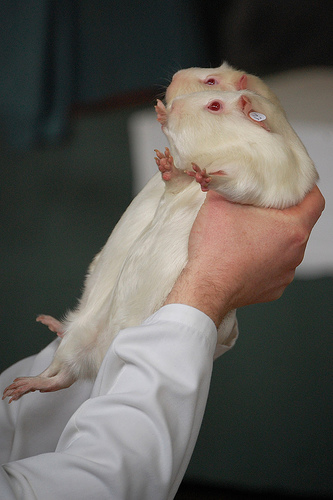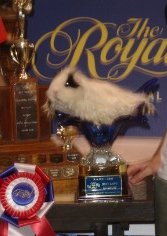
"Hum...which to choose?"

Winner takes all!
Showing guinea pigs???
The very thought of showing guinea pigs creates titters, piques curiosity and has even been known to cause the corner of the mouth of the sternest of Customs officers to turn up in a little grin. Yes – there are shows for guinea pigs. A lot of people have no concept of how a guinea pig would be shown. There are not on leads like dogs or larger livestock. They do not go through repertoires like obedience trained dogs; rather they are presented to the judge at the judging table. Basically guinea pigs or cavies as they are known to the fancy are judged on body shape, condition and coat.
There are no less than 17 breeds of cavies recognized by the Ontario Cavy Club. The cavy breeds are all basically the same size and shaped cavy but with different coat types, lengths, patterns. The breeds are Abyssinian, Satin Abyssinian, Boucle (Alpaca), Coronet, Crested, Satin Crested, Merino, Peruvian, Satin Peruvian, Silkie, Satin Silkie, Skinny, Smooth Coat, Satin Smooth Coat, Teddy, Satin Teddy and Texel. The Ontario Cavy Club publishes two beautiful, fully illustrated standards of perfection—one for standardized breeds and one for non-standardized breeds and colours (Rare Varieties). It is available to all members in the file section of the Members Only Facebook group.
All breeds are showable in all 27 colour varieties. The self varieties are all one colour – beige, black, buff, chocolate, cream, lilac, orange, red, slate blue and white.
Agouti varieties have “banded” hairs with the base and the very tip of the hair shaft being black, chocolate, slate blue, lilac or beige. There is a band of red, orange, buff, cream or white between the base & the tip. The belly of the cavy has a band of the red, orange, buff, cream or white. The three agouti varieties are dilute agouti, golden agouti and silver agouti.
The three Solid varieties are solid dilute, solid golden and solid silver. The Solid varieties have the same colour combinations as the Agoutis but there is no belly band, the entire body is to be evenly tipped.
Marked varieties are Dalmatian (spotted similar to the dog breed), Dutch (marked like the Dutch rabbit), Himalayan (white body with black points and pink eyes, marked similar to a Siamese cat), Parti (patched with two or more colours excluding the Tortoiseshell and Tortoiseshell and White colours), Tortoiseshell (patched with red and black) and Tortoiseshell and White (patched with red, black & white).
There are 2 Other Varieties – Roan & Brindle. Brindle has two self colours intermixed – white cannot be one of the colours. Roan is any self (except white) or agouti or solid coloured hairs interspersed evenly with white.
The most recent colour variety additions are the Marten, Tan and California. Marten and Tan are classed under Tan Pattern. These are the “Doberman” marked cavies with a body colour of black, chocolate, slate blue, lilac or beige with white markings on the Marten and red markings on the Tan. The California is marked similar to the Himalayan; body colour is to be buff, cream, orange, red or white with black, chocolate, slate blue, beige or lilac markings (the eyes match the marking colour).
Check out the Breeds and Varieties section on this website for pics of the different breeds and varieties.
Cavies are shown in 3 age/weight groups – senior, intermediate and junior. Seniors are over 6 months with a minimum weight of 32 ounces. Intermediates are 4 to 6 months old weighing between 32 and 22 ounces. Juniors are under 4 months of age weighing between 22 and 12 ounces. There are classes for boars and sows. For example if your cavy is a Smooth Coat, is black, is over 6 months of age and 32 ounces in weight and is a sow she would be shown as a Smooth Black Senior Sow.
Cavies are entered by their Colour Variety so there is no need to be specific about the exact colour combination in Dutch, Dalmatian, Dilute Agouti, Solid Dilute, Brindle, Roan, Parti, Marten, Tan and California. A black roan cavy would simply be entered as Roan or a golden agouti, red and white parti colour would be entered as Parti.
You do have to put on your entry whether your Crested cavy is a White Crested or a Self Crested.
OCC also has three special classes—Sow & Litter (up to 4 weeks of age), Boar & Son (son must be 4 to 8 weeks of age) and Breeders Herd (classes for both pairs and trios). OCC also has three special classes—Sow & Litter (up to 4 weeks of age), Boar & Son (son must be 4 to 8 weeks of age) and Breeders Herd (classes for trios). These do not compete for Best in Show.
The current Rare Variety Breeds are Baldwin, Crested Ridgeback, Crested Teddy, Lunkarya, Satin Boucle, Satin Coronet,
Satin Crested Ridgeback, Satin Crested Teddy, Satin Merino, Satin Smooth Coat Ridgeback, Satin Swiss, Satin Texel, Smooth Coat Ridgeback, and Swiss. The current Rare Variety Colours are California Roan, Chocolate Himalayan, Dapple, Magpie, Otter, Rainbow, Sable (Royal Mauve), Seal (Sepia) and Tan Roan. These also do not compete for Best in Show.
Cavies are brought to the judging table and placed in judging coops (except for long coated cavies which are presented to the judge on a show board). The judge examines each cavy for disqualifications, eliminations and quality. The cavies are placed in their class and first place winners go on to compete for the best of their colour variety. The best of varieties compete for best of breed. After all breeds are judged, all best of breed winners return to the table for the selection of best in show.
To answer some of the common questions :
1. You do not need to be a member to show at an OCC show (you do need to be a member to compete for sweepstakes points).
2. Your cavy does not need to be purebred or pedigreed to compete in shows. Cavies are judged on phenotype (appearance) not genotype (pedigree and genetic make-up).
3. Cavies are not required by the OCC to be ear tagged or tattooed.
For information on upcoming shows, check out the OCC newsletters and/or website (http://ontariocavyclub.com/). For specific questions,please contact Amber Gilbert, OCC Show Chairperson. The OCC has up to 11 shows per year with the annual convention show in the spring being the highlight of the show year. All OCC shows require sending your entry in ahead of time by email, ground mail or phone.
